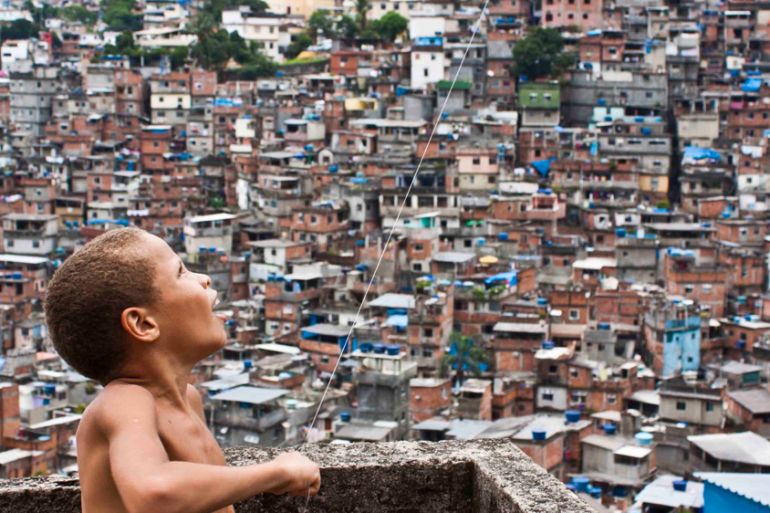
Rio de Janeiro: In the Shadow of the Hill
Rio de Janeiro favela residents rally against police brutality, corruption, impunity and ruthless state oppression.
Editor’s note: This film is no longer available to view online.
In November 2011 military police took control of Rio de Janeiro’s largest favela, Rocinha, forcing out armed gangs of drug traffickers without a single shot fired, in a government initiative to “pacify” the slums.
Keep reading
list of 4 itemsNigeria’s women drivers rally together to navigate male-dominated industry
‘I blame the government’: Poor Kenyans say no support amid record flooding
‘We need you’: Solomon Islands’ support for US agency’s return revealed
However, shortly afterwards reports began to emerge of widespread police abuse, which culminated in the disappearance of local bricklayer Amarildo de Souza.
He was last seen being taken into the police station for questioning but never came home. His family believed that he was tortured and murdered by the police, with impunity, like many other innocent civilians in the city.
In the face of brutal oppression, local residents started a protest movement, “Where is Amarildo?”, that shook the Brazilian establishment to the core. _____________________________________________________________________________________
FILMMAKER’S VIEW
By Dan Jackson
I first visited Rocinha just a few months after the “pacification”, an eerily Orwellian term for the state-sanctioned reclamation of territories previously controlled by drug-trafficking armies. I was immediately struck by the close-knit nature of the community, the warmth and care for one’s neighbours, qualities I feel are fast disappearing in the Western world.
I was immediately drawn in and, from very early in the production process, felt like I was at home. It wasn’t until my third trip to the community that local bricklayer, Amarildo de Souza, was picked up for questioning by the authorities.
Up until this point, many rumours had circulated about rampant police abuse in Rocinha. In fact, there had been 22 formal accusations of torture at the hands of the authorities, which had been summarily dismissed by the judicial system. My inclination was that this was the sinister tip of a far-reaching and deeply entrenched iceberg.
The difference in this particular case was the presence of security cameras, which clearly depicted Amarildo being handcuffed and put inside a police cruiser.
Just days after the bricklayer’s disappearance, I met his family at a small protest at the bottom of the favela. They were convinced that he had been murdered by the police, and I had no reason to doubt the veracity of their claims.
![In the face of oppression, residents of Rio's favelas started a protest movement that would shake the Brazilian establishment to the core [Al Jazeera]](/wp-content/uploads/2016/11/29b505a78deb45fea38ac6af8042057e_18.jpeg)
At the same time a nationwide protest movement was developing, started by an arbitrary hike in public transport cost. It would go on to be the largest protest movement since the fall of the US-backed military dictatorship in the mid-1980s.
The protesters’ grievances were varied: endemic government corruption, outrageous public spending on the upcoming sporting mega-events and systemic police violence disproportionately targeting the poor and black.
These were among the long list of injustices criticised by the movement. In covering these protests, I gained an insight into the brutally repressive tactics used by the military police.
I was tear-gassed and pepper-sprayed but remained cognizant that these methods paled in comparison to what was happening in Rio’s favelas.
In Rocinha, Amarildo’s family continued their fight for justice, as more and more residents joined the almost nightly protests.
The power of the camera became apparent: an inverse relationship developed between the presence of independent journalists and the likelihood of violent repression by an ever-watchful military police.
In any other year this may have been different, but with the upcoming sporting mega-events the eyes of the world were on Brazil and the authorities were forced to tread a very fine line.
The news of Amarildo’s disappearance eventually hit the mainstream and he became a martyr figure for the national protest movement, bringing together the middle-class and poor, catalysed against Brazil’s ruling elite.
Without wanting to give too much away, it suffices to say that the movement would go on to shake the Brazilian establishment to its core.
In the Shadow of the Hill aims to give testament to the inherent power of the voiceless, for within each individual resides the ability to create far-reaching and tangible change. If a spark can create a fire that burns down an entire forest, so too can a poor, marginalised resident of a favela ignite a change that transforms a nation.
![Between 2007 and 2013, ahead of the 2014 FIFA World Cup and 2016 Summer Olympics, 38,000 people mysteriously disappeared from Rio de Janeiro's densely populated slums [Al Jazeera]](/wp-content/uploads/2016/11/dff8f7f580d44bfcab28a86358519db0_18.jpeg)